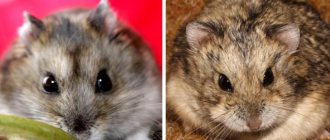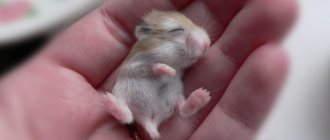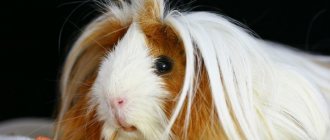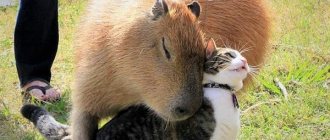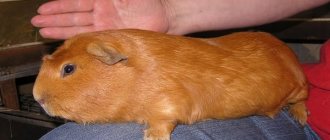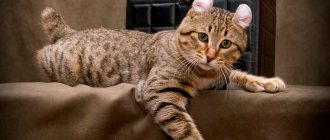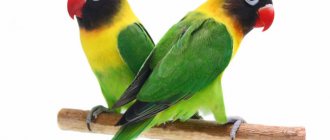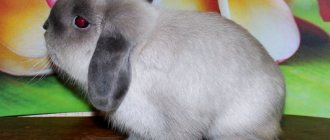Common hamsters, which are most often kept at home, are distinguished by the special structure of their dental system. They have incisors on each jaw, and their growth does not stop throughout their lives. Hamsters constantly wear them down on hard food or pieces of wood, which is the reason for their habit of gnawing on everything that is available around them.
Dental disease is a serious problem for these animals. Hamsters cannot eat normally, and this has negative consequences for the entire body, so it is important to help them in time.
How many teeth does a hamster have?
Although Djungarian, Syrian and other varieties of hamsters only have a few visible front teeth, their mouthparts are more complex than they appear. Therefore, answering the question of how many teeth are in a rodent’s mouth is not easy at first glance. However, as statistics show, any healthy representative of the Hamster subfamily has 16 of them, 4 of which are powerful front incisors, and the remaining 12 are evenly located on each jaw. This feature allows the animal to process almost any food and roughage. At the same time, despite some differences between breeds and decorative hybrids, the principles of the structure of the oral apparatus are the same.
Important! It is not normal for a hamster to have snow-white teeth. In most cases, this indicates disorders or serious illnesses.
Features of anatomy and physiology
Domestic rodents are divided by type of food. It is important for owners to know this in order to formulate a daily diet correctly and not give something that will cause gastrointestinal diseases.
Groups of food addictions:
- omnivores, these include gerbils, rats, hamsters;
- herbivores include degus, chinchillas, rabbits, and guinea pigs.
Important! The term “omnivore” does not mean that domestic rodents must eat everything. You cannot give them food from the table, spicy meat products, cookies, or anything that a person eats himself.
These rodents differ from each other in the type of nutrition, diet and physiological characteristics of the formation and growth of teeth, especially molars.
Herbivores are those whose teeth continue to grow throughout their life. That is, you need to grind down both the incisors and molars.
Omnivores - their front incisors are characterized by the intensity of growth, the molars remain in a stable condition.
It is a mistake to think that rodents grind their teeth only on hard surfaces; this primarily occurs due to friction between the upper and lower rows. In this case, “self-sharpening” of the teeth occurs; their sharpness depends on the frequency of friction between each other.
Mineral stones, sticks, and solid food also contribute to the grinding process, but to a lesser extent. It is also advisable to show your pet to a veterinarian once every 1-2 months to assess the degree of risk of injury to the soft surfaces of the oral cavity and, if necessary, the specialist will trim an overgrown incisor or molar.
Why does a hamster have yellow teeth?
The natural shade of the teeth of the dwarf and other species of hamsters is yellow. This color speaks of good health and healthy metabolism. With age, the shade may change - in adult animals it is darker and more saturated, even yellow-brown. In a young hamster, on the contrary, the color is less bright, pale yellow. This is explained by the presence of so-called xanthophylls in the enamel, which contribute to the acquisition of a characteristic shade.
Oral diseases: treatment and prognosis
The problem of malocclusion will be lifelong. Therefore, the owner will have to regularly visit a specialist (every 2-6 months) and correct the dental problem. The treatment is based on filing the tooth, adjusting its height and removing “tooth hooks” on the molars.
For this, various dental devices are used, the operation is performed under general anesthesia - gas anesthesia is used, since intravenous drugs for a rodent are very difficult to dose and administer.
In an advanced state, treatment of the consequences will be required - removal of abscesses, wounds, treatment of conjunctivitis, etc. The prognosis depends on when the owner of the rodent went to the clinic, how extensive and advanced the problem is. At an early stage, correcting tooth growth completely eliminates the development of dental syndrome. Regular examination by a veterinarian is an opportunity to prolong your pet’s life and make it comfortable.
If you notice that your pet rodent is behaving unusually, is refusing food, or has become unkempt in appearance – don’t hesitate! Call the Ros-Vet VC and make an appointment with a ratologist by phone, 24 hours a day.
Why do hamsters need to sharpen their teeth?
One of the characteristic features of hamsters' front teeth is that they are capable of growing throughout the rodent's life. This allows him to eat well into old age and not deny himself anything. However, in some cases this leads to all sorts of problems. Indoor hamsters do not have the ability to process excessively dense and rough food, so their teeth can grow to an uncharacteristic size.
Find out how long hamsters of different breeds live.
In addition to a purely aesthetic problem, this pathology often leads to damage to the oral cavity. Such wounds are very painful for the animal and are often infected with pathogenic viruses and bacteria. Also, large teeth can interfere with proper nutrition and food processing. That is why a rodent must sharpen its incisors throughout its life, both with rough food and on all kinds of hard objects.
Malocclusion and occlusion in rodents
Occlusion is the exact alignment of the upper and lower rows of teeth when chewing food. A slight displacement to the side is enough and the grinding of the surfaces will occur unevenly, the growth of the teeth will be excessive, and one incisor (or molar) may be smaller than the neighboring one. The appearance of sharp edges, shoots, and fragments is dangerous for the pet; they injure surrounding tissues, causing inflammation and suppuration.
Malocclusion is a disease that is characterized by improper formation of the dentition due to poor wear of teeth and the formation of pathological surfaces. Actually, malocclusion is the process of improper grinding of dental surfaces; at first glance, it is not dangerous, but as a result it can lead to the following problems in the oral cavity in rodents:
- wounds, ulcers on the oral mucosa;
- changes in tooth root growth;
- infection of periarticular tissues and organs. Bacterial microflora and purulent foci can spread to bone tissue, conjunctival sac, and postorbital space. As a result, abscesses, conjunctivitis, and osteomyelitis develop;
- deformation of the temporomandibular joint.
Any discomfort in a rodent's mouth does not allow it to eat normally, and apathy, exhaustion, dehydration, and disruption of the gastrointestinal tract develop. With purulent processes, there is a threat of blood poisoning (sepsis) and the development of secondary pathological processes, such as rhinitis, dermatitis, pododermatitis, etc.
Important! A veterinarian-ratologist, having identified the root cause of diseases that have developed in a rodent, makes a diagnosis and summarizes it with one name: “dental syndrome”.
What to give a hamster to wear down its teeth
Not allowing your hamster to wear down its teeth will cause many problems over time. First of all, the rodent will begin to grind them on any hard objects in the cage. This often leads to the pet damaging all wooden, metal and plastic objects, as well as toys, even the protective coating on the cage bars.
Important! Branches must be selected in environmentally safe areas, away from highways and industrial enterprises. Otherwise, they may contain harmful and life-threatening toxins for the hamster.
To avoid this, it is recommended to provide his diet with roughage as much as possible. If this is not enough, the hamster should be given a special sharpener to chew on. In winter, grain sticks are used for grinding; as an alternative, you can use mineral or chalk stone. In summer and other warm periods of the year, young branches of fruit trees are suitable for this purpose. In this case, the branches of plum, cherry, pear or apple trees are considered the most suitable and safe.
What the owner might notice
The first thing the owner notices is that the rodent refuses food. This is obvious, since deformed teeth do not allow him to chew food well. Drooling is possible; if the gums are damaged, the saliva turns red.
Additional symptoms:
- poor appearance, the animal is unkempt, stops caring for its fur;
- when there is a lack of food, the fur begins to droop;
- progressive exhaustion;
- growth of teeth to the outside or inside the oral cavity;
- inflammatory process of gums, lips;
- formation of abscesses during wound suppuration;
- lacrimation turning into purulent conjunctivitis;
- no bowel movement.
The entire symptom complex progresses very quickly, so even in the event of refusal of food, non-standard behavior of the rodent, or minor external changes, you need to consult a veterinarian. Slight tooth growth can be corrected by removing excess overgrowth, trimming incisors and molars. The longer the owner postpones a visit to the veterinary clinic, the higher the risk of developing irreversible consequences.
Possible problems
Ornamental animals at home are often deprived of the instincts and way of life that are inherent in their relatives in the wild. That is why this often leads to many problems, including those with the oral cavity. That is why, regardless of age and conditions of detention, attention should be paid to the pet every day.
What to do if your teeth don't sharpen
A huge number of hamster owners face this problem. It often occurs as a result of an unbalanced diet or if the animal’s natural instincts at home are somewhat dulled. Often this phenomenon is accompanied by general lethargy of the rodent or other symptoms indicating systemic ailments. Therefore, it is recommended that your hamster be thoroughly examined by a veterinarian.
Did you know? Roborovsky's hamster is recognized as the smallest hamster in the world. This rodent lives in Mongolia, its average length reaches 4–5 cm, and its weight does not exceed 30 g.
If the rodent is completely healthy and simply does not have time to wear down its teeth, they definitely need to be trimmed. To do this, you need to take nail scissors or nail clippers for cats. This must be done carefully, with smooth movements, up to a length of 5 mm. At the same time, it is also recommended to trim the claws on the paws so that the hamster does not injure himself and others. However, it is recommended to do all this at home only if you have the appropriate skills. In other cases, it is strongly recommended to consult a veterinarian.
Broken upper or lower tooth
Also, often during active games, an animal can break its front incisor. In this case, the lower or upper tooth can break on its own, due to an unbalanced diet or in adulthood. If you do not take decisive action, this can lead to serious problems in just 1-2 weeks.
Pay attention to the description of the Angora hamster.
First of all, the sharp edge can injure the oral cavity, which will cause many difficulties for proper nutrition. It should also be taken into account that the incisors do not grow synchronously, so over time the difference between the length of a healthy and broken incisor will be significant. To prevent all this from happening, the broken incisor must first be polished with a nail file. After this, the adjacent long tooth must be shortened to the length of the broken one.
Uneven growth of incisors
This problem can arise due to a number of factors, which also include genetic predisposition and the impact of closed living conditions. That is why it is not easy to accurately answer the question of why this happens. This pathology can take on a varied type of course, with each incisor growing either asynchronously or in pairs. In the latter case, there is a pathological enlargement of the two lower or two upper teeth, which can reach truly gigantic sizes.
To help the animal, the incisors need to be shortened to a single length. After this, you should definitely review the hamster’s diet by adding an additional portion of dry food, as well as fresh branches of fruit species.
What to do if your teeth are chattering
Sometimes a characteristic knocking sound may indicate problems with teeth. This occurs due to an incorrect taste caused by excessively long incisors. As a result, the pathological process leads to unpleasant or painful sensations that contribute to severe discomfort. This is especially evident with uneven growth of the incisors and subsequent distortion of taste.
Did you know? Hamsters are considered one of the most ancient rodents. They appeared on the planet long before humans, back in the Miocene era (8–12 million years ago).
However, a hamster can chatter its teeth even with a whole range of ailments, including cancer. That is why, when such a problem occurs, you need to contact a veterinarian as soon as possible. Often this will help prevent the development of serious consequences and death of the pet.
When you need help
No normal animal lover would deny the importance of dental health for pets. If the animal does not sharpen as needed, the incisors will become crooked or overgrown.
It is important to pay attention to this, since the life of hamsters depends on it. In this case, the animal may even die from hunger. To prevent this from happening, you need to contact a veterinarian and trim it. When the length is normal, he will be able to grind them down himself. You should not shorten long incisors yourself.
Features of keeping and feeding hamsters at home
Certain types of hamsters most often serve as pets:
- Syrian;
- Dzungarian;
- Campbell;
- Roborovsky.
The list is compiled taking into account the popularity and prevalence of hamsters of this breed. Thus, “Syrians” are found very often, while Roborovsky’s hamsters are practically never found in pet stores, and you can only buy them from a breeder.
Syrian hamsters are the largest animals, 13-14 centimeters long and weighing up to 120 grams. There are smooth-haired and long-haired (the latter are often mistakenly called “Angora”). Djungarians and Campbell's hamsters are commonly called “dwarf” hamsters. Both species belong to the genus Hairyfoot, have a length of up to 10 cm and a weight of up to 65 grams, differ mainly in color, and can produce viable offspring during interspecific crossing. Roborovsky's hamsters, also belonging to the genus of boll-legged hamsters, are the smallest: weighing up to 25 grams and up to 5 cm long.
The type of hamster directly affects its diet. Smaller furry-legged animals have a faster metabolism compared to “Syrians”; in addition, the smaller volume of cheek pouches imposes restrictions on the size of food pieces. Large manufacturers produce, in addition to “standard” ones, specialized foods for dwarf hamsters that take these features into account.
Other diseases of hamsters
Tumor in a hamster
A tumor in a hamster is a disease caused by the appearance of a neoplasm in the body in the form of a malignant tumor.
- The reasons are genetic predisposition. Some foods may have a positive effect on the development of cancer in hamsters. Older individuals also have a tendency;
- symptoms - signs depend on the location of the tumor, they can be different organs, and symptoms are vomiting, diarrhea, impaired movement, interruptions in the functioning of the body in general, etc.;
- treatment - involves the removal of a malignant neoplasm, but only if necessary.
Hamster heart disease
A hamster has heart disease - characterized by interruptions in the functioning of this organ. They are quite rare in hamsters.
- reasons - the presence of severe stress or high air temperature, which affects the regulation of the heart muscle;
- symptoms - shortness of breath, high pulse, apathy and decreased activity;
- treatment - in the first stages of treatment, it is recommended to change the conditions of the hamster’s keeping. If this does not help, and the condition only worsens, you need to administer an injection of Effortil. Again, all treatment is prescribed strictly individually. Self-medication should be excluded.
Colds are also a hamster disease
- reasons - may be hypothermia or the effect of a virus;
- symptoms - general weakness, sneezing, nasal discharge, discharge from the eyes;
- treatment - it is recommended to give pets fruits that are saturated with liquid to prevent dehydration. If colds are started, they can develop into more serious ones.
What do hamsters sharpen their teeth with?
A rodent will always find something to sharpen its incisors. If there are no pebbles or pieces of tree bark nearby, the animal begins to chew on the cage bars. To prevent the animal from suffering from gnawing metal bars, the owners need to provide the pet with special devices for sharpening its teeth. It is recommended to purchase a mineral stone for rodents and parrots at a pet store. If there is a garden near your house, you can break off several branches of fruit trees and put them in a cage. When a hamster chews on a chalk stone and tree bark, it not only wears down its incisors, but also supplies the body with a large amount of useful substances. It is important that the animal has solid cereal food in its feeder every day. An animal that eats soft foods inevitably deteriorates its teeth and deteriorates in health.
Treats
Today, the pet store can offer another option for grinding teeth - grain sticks. They come in different grain compositions with the addition of various minerals and trace elements. This delicacy will definitely please your taste! You can also prepare your hamster’s liver yourself!
cereal sticks
In addition, if you tie the treat in such a way that the hamster has to work hard to get to it, then it will also serve as good entertainment and additional physical activity for your pet.
A hamster should not chew ordinary school chalk; after all, it is non-food and is not intended for such purposes. Food products undergo several degrees of purification, so they are safe for the animal.
Djungarian hamster: features of communication with the animal
The Djungarian hamster, the photo of which is presented below, is a cute and harmless animal. But this little family member also has his own character and behavior. Here's what you need to know when establishing communication with Djungarians:
Relationships with relatives
Djungarian hamsters live alone in nature. If you want to get offspring, then take two rodents from the same litter. Even in this case, they may not get along with each other, and then battles are guaranteed. Dzungariks defend their territory aggressively and assertively, so they fight until there is blood. Keep this in mind if you decide to add a Djungarian or Syrian neighbor to your rodent.
If the female is expecting offspring, move the male to a separate “apartment”. Pregnancy is stressful for both parents, so one of them will definitely eat the offspring.
Photo: pixabay.com: UGC
Djungarian hamster in the same territory with dogs and cats
The presence of a larger predator next to the cage will in no way disrupt the peaceful course of life of the rodent. A smart dwarf will quickly understand that the bars of his cage protect him from the claws and teeth of a cat or dog and will stop paying attention to their attempts to pull him out of the cage. He will also run quickly, rummage through sawdust, and carry grains. Sometimes it will do this on purpose to tease predators.
The danger lies in the hamster's curiosity and energy, which force him to leave the cage at the earliest opportunity. Then his life is in danger. So remember to close the cage, play and train your hamster, making sure there are no other animals in the room.
Communication between a dzhungarik and a person
The smart and funny hamster is easy to tame. He will happily leave the cage to run and frolic in a small space. Rodents react well to children, do not bite, but always try to escape. Since they are fragile and delicate, during play, make sure that the hamster does not get injured by falling from a height or getting stuck between two objects.
Photo: pixabay.com: UGC
To minimize the stress of taming a dwarf:
- In the first week of life in a new place, allow the rodent to adapt. Place the cage so that he can observe people's movements, but so that the noise is minimal.
- Do not disturb the animal during daytime sleep.
- Don't "rob" his bins.
- In the first weeks, watch his games and talk to the animal so that he gets used to the human voice and his presence.
- Lure him out of the house by offering him treats - nuts or dried fruits. After a while he will get used to eating from his hands and sitting on his palm.
Djungarian hamsters are ideal pets for small children. Children 3–4 years old enjoy caring for these animals: feeding them and helping with cleaning. Unpretentiousness and ease of care, lively character and comic actions make the Djungarians family favorites.
